Considering adding a furry friend to your family and wondering about the popular Dog Breed Breeds Of Dogs In India? The decision to bring a dog home is a significant one, and understanding which breeds thrive in the Indian climate and lifestyle is crucial. With their unwavering loyalty and boundless affection, dogs have become cherished members of households across the nation. The demand for various dog breeds in India has seen a steady rise over the years, reflecting a growing love for canine companions. This guide delves into some of the most sought-after breeds, offering insights into their history, characteristics, temperament, and care requirements, helping you make an informed choice for your home. Before you commit, it’s also wise to understand the cost of dog breeds in India to prepare for the financial aspects of pet ownership.
German Shepherd
The German Shepherd stands out as one of India’s most unique and beloved dog breeds, admired for its intelligence, obedience, loyalty, confidence, and courage. These dogs are highly adaptable and form strong bonds with their families.
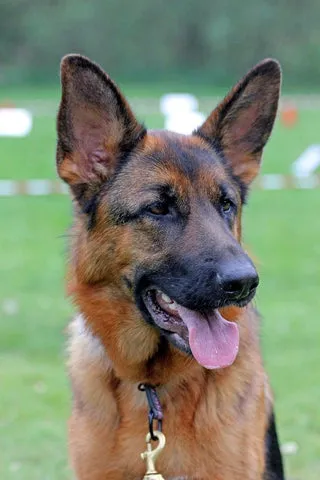 A majestic German Shepherd dog with a tan and black coat, looking alert and intelligent, representing a popular dog breed in India.
A majestic German Shepherd dog with a tan and black coat, looking alert and intelligent, representing a popular dog breed in India.
A Brief History: Originally known as Alsatians, German Shepherd Dogs were bred in Germany during the late 19th century to assist shepherds in herding and protecting sheep. They were valued for their working capabilities rather than as pets. Their popularity surged globally after World War I, cementing their reputation as intelligent and capable dogs.
| Features | Details |
|---|---|
| Size | Large |
| Height | 21 to 25 inches |
| Weight | 35 to 45 kilograms |
| Characteristics | German Shepherds are known for their agile and strong build, featuring square heads and distinctive erect, pointed ears. They possess long, bushy tails, and their double coats can range in color from classic tan with a black saddle to solid black or even white. Their medium-length double coat is prone to moderate to heavy shedding. |
| Group | Herding Group |
| Temperament | Intelligent, self-assured, obedient, protective, alert, and active, making them excellent guard dogs and family protectors. |
| Exercise | Being active and athletic, German Shepherds require significant daily exercise to maintain both mental stimulation and physical well-being. This can include long walks, runs, and engaging play sessions. |
| Grooming | Due to their propensity for shedding, daily brushing is recommended, increasing to twice a day during peak shedding seasons, to manage loose hair. Regular baths (every 10-15 days) help keep their coat clean, and their nails must be trimmed regularly to prevent discomfort and potential issues. |
| Health conditions | This breed should be screened for conditions like degenerative myelopathy and elbow and hip dysplasia. They are also susceptible to bloating (gastric dilatation-volvulus), which requires immediate veterinary attention if suspected. |
| Food Doggie Dabbas Recommends | High-Value Training Treats, Sardine Oil, Hemp Seed Oil |
| Fresh Meals | Mutton & Parsley, Chicken & Mint, Fish & Dill, Chicken & Pumpkin, Chicken Jerky, Liver it Up, Fish Ferky |
Great Dane
For individuals drawn to colossal canines, the Great Dane is an exemplary choice. These gentle giants are not only affectionate companions but also vigilant and formidable home guardians, making them a popular dog breed in India for those seeking a large, protective pet. They hold the distinction of being among the tallest dog breeds globally, with records like Zeus, a Great Dane, once holding the title of the tallest dog on Earth.
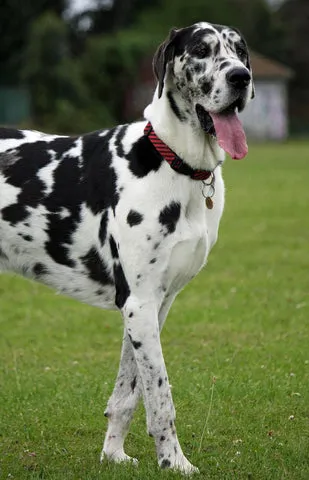 A towering Great Dane standing tall and majestic, showcasing its impressive size and calm demeanor, ideal for large dog enthusiasts.
A towering Great Dane standing tall and majestic, showcasing its impressive size and calm demeanor, ideal for large dog enthusiasts.
A Brief History: The Great Dane boasts a German heritage spanning over 400 years. Descended from mastiff-like dogs, they were historically renowned for their prowess in hunting wild boars. These majestic dogs were primarily assets of the nobility, utilized for sport and the protection of estates and carriages.
| Features | Details |
|---|---|
| Size | Large |
| Height | 29 to 33 inches |
| Weight | 60 to 90 kilograms |
| Characteristics | Great Danes are characterized by their long, muscular bodies and strong necks. They have medium-length tails and are generally light to medium shedders. Their imposing stature is matched by their graceful movement. |
| Group | Working Group |
| Temperament | Friendly, reserved, confident, docile, gentle, and devoted, often referred to as “gentle giants.” |
| Exercise | Daily exercise is essential for Great Danes, but the intensity must be appropriate for their age. Puppies should not be subjected to rigorous activities to protect their growing joints. Exercise should ideally take place outdoors on proper ground, as prolonged activity on hard surfaces like marble or tiled flooring can be detrimental over time. |
| Grooming | This breed has a smooth, short coat and is not excessively prone to shedding. Weekly brushing helps manage any loose hair. They only require occasional baths, and regular nail trimming is crucial to prevent discomfort and mobility issues. |
| Health conditions | Great Danes are highly susceptible to gastric dilatation-volvulus (GDV) or bloat, a life-threatening condition. Many owners, under veterinary guidance, consider prophylactic gastropexy surgery to mitigate the severe effects of GDV. They should also be screened for hypothyroidism, cardiac diseases, and hip dysplasia. |
| Food Doggie Dabbas Recommends | Chicken Jerky, Fish Ferky, Berryblast Cheese Jerky, Blueberry Chicken Jerky, Chicken & Pumpkin, Cottage Cheese & Carrot, Fish & Dill, Mutton & Parsley, Sardine Oil, Hemp Seed Oil |
Beagles
Originating from the French word “Beguele,” Beagles are among the most adorable and globally popular dog breeds, and are a high-ranking choice among the cutest dog breed breeds of dogs in India. These small, compact dogs make ideal companions and family pets.
 A curious Beagle puppy with soft floppy ears, looking friendly and energetic, ready for playtime.
A curious Beagle puppy with soft floppy ears, looking friendly and energetic, ready for playtime.
A Brief History: Beagles descended from hounds and were predominantly used for hunting due to their keen sense of smell and manageable size. A unique variety, known as ‘pocket beagles,’ was once carried in hunters’ coat pockets, proving highly effective in tracking rabbits, jackals, and pigs.
| Features | Details |
|---|---|
| Size | Medium |
| Height | 19 to 22 inches |
| Weight | 10 to 15 kilograms |
| Characteristics | Beagles are muscular dogs with slightly domed skulls, long tails carried happily, and distinct squarish muzzles. Their expressive faces and compact build contribute to their charm. |
| Group | Hound Group |
| Temperament | Friendly, reserved, confident, docile, gentle, and devoted. They are known for their merry and curious nature. |
| Exercise | Beagles require substantial daily exercise, with a minimum of one hour recommended. Exercising them with companionship (human or canine) is beneficial for their mental and emotional health. They also need mental stimulation through sniffing games and new toys to maintain good health and prevent boredom. |
| Grooming | Beagles have a smooth, double coat and shed moderately throughout the year. Weekly brushing helps remove loose hair and promotes healthy coat growth. They do not require frequent baths, and their nails should be trimmed regularly to avoid pain and discomfort. |
| Health conditions | This breed is susceptible to conditions such as hip dysplasia, epilepsy, luxating patella, and hypothyroidism. Their long, floppy ears must be cleaned weekly to prevent infections, and regular teeth brushing is essential for oral hygiene. |
| Food Doggie Dabbas Recommends | High-Value Training Treats, Fresh Meals – Chicken & Pumpkin, Chicken & Mint, Fish & Dill, Mutton & Parsley, Cheese Jerky, Sardine Oil, Hemp Seed Oil, Freshibble |
Golden Retriever
Golden Retrievers consistently rank as one of the most popular dog breed breeds of dogs in India. Once favored by Indian royalty decades ago, these dogs are now invaluable assets to dog enthusiasts across the country and are considered among the best dog breeds for families in India.
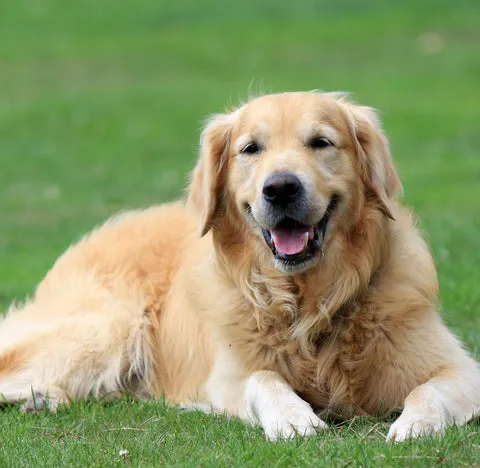 A friendly Golden Retriever with a beautiful golden coat, looking attentive and gentle, an ideal family pet.
A friendly Golden Retriever with a beautiful golden coat, looking attentive and gentle, an ideal family pet.
A Brief History: Primarily bred in Scotland in the mid-19th century to be a bird-dog, specifically for retrieving waterfowl, the Golden Retriever was developed by crossing various breeds including spaniels, setters, and the now-extinct Tweed Water Spaniel, with some influence from Newfoundland and possibly even a Bloodhound. This careful amalgamation resulted in a strong-swimming, water-loving dog capable of tracking wounded prey and retrieving birds from land and water.
| Features | Details |
|---|---|
| Size | Medium to Large |
| Height | 21 to 22 inches |
| Weight | 25 to 29 kilograms |
| Characteristics | Golden Retrievers are recognized by their dense, water-repellent double coats, which can be wavy or flat, and typically come in shades of golden, light-golden, and cream. They feature distinctive feathering on their neck, legs, and thighs, along with a broad, robust head. |
| Group | Sporting Group |
| Temperament | Intelligent, kind, trustworthy, confident, friendly, and reliable, known for their gentle and eager-to-please nature. |
| Exercise | Golden Retrievers require abundant exercise to stay healthy and happy. Engaging them in activities such as hunting trips (if applicable), long runs, brisk walks, and bike rides can easily fulfill their exercise needs. |
| Grooming | This breed sheds moderately on an ongoing basis. Daily brushing, increasing to twice a day during shedding seasons, helps remove dead hair and reduces household cleanup. Frequent baths are beneficial for loosening dead hair and keeping their coat clean. As with all breeds, their nails must be kept short to prevent discomfort and potential injury. |
| Health conditions | Golden Retrievers should be screened for elbow and hip dysplasia, retinal atrophy, and cardiac diseases such as subvalvular aortic stenosis. Regular checks of their ears and teeth for signs of infection are also important. |
| Food Doggie Dabbas Recommends | High-Value Training Treats, Jerky Treats, Fresh Meals |
Pug
Named after the Latin word meaning ‘clenched fist,’ Pugs are truly “big dogs in little bodies,” possessing immense charm that has significantly boosted their popularity as a dog breed breeds of dogs in India. Their unique appearance and loving nature make them highly sought-after.
 A charming Pug with its characteristic wrinkly face and curled tail, looking endearing and expressive.
A charming Pug with its characteristic wrinkly face and curled tail, looking endearing and expressive.
A Brief History: Pugs have a rich history dating back to as early as 400 B.C., originating from China. They were primarily bred as companions for royalty and were even cherished by Tibetan Buddhist monks. Chinese emperors held them in such high esteem that they employed guards specifically for their protection. In India, the popularity of Pugs soared following Hutchinson Essar’s (a cellular network) advertisement campaign featuring Cheeka the pug, which created a sustained trend in demand for the breed. If you’re considering an American Pit Bull, you might also want to research details on American Pit Bull Terrier prices in India.
| Features | Details |
|---|---|
| Size | Small |
| Height | 10 to 12 inches |
| Weight | 6 to 10 kilograms |
| Characteristics | The most distinctive features of Pugs are their small, wrinkly faces, often described as ‘clenched,’ and their tightly curled tails. They possess a fine, glossy coat that comes in various colors, most commonly fawn or black, and a compact, square body with well-developed muscles. |
| Group | Toy Dog |
| Temperament | Charming, playful, docile, clever, friendly, and loving, Pugs are known for their strong personalities despite their small size. |
| Exercise | Pugs require a moderate level of exercise, which can include daily play sessions and leisurely walks in a park. It is crucial to note that Pugs cannot tolerate hot weather well, so strenuous activity should be avoided when outdoor temperatures are high to prevent overheating. |
| Grooming | Dogs of this breed have a smooth, glossy coat that sheds moderately. Weekly brushing is usually sufficient to remove loose hairs. They do not require frequent baths, and their nails must be trimmed regularly to prevent discomfort. Special attention must be paid to cleaning and thoroughly drying the rolls of skin on their face after baths to prevent skin infections. |
| Health conditions | Pugs are susceptible to hip dysplasia, stenotic nares (pinched nostrils), corneal ulcers, and dry eyes. Due to their brachycephalic (flat) faces, they often experience breathing issues, such as reverse sneezing, particularly in hot and humid weather. |
| Food Doggie Dabbas Recommends | Jerky Treats, Supplements, Fresh Meals |
Pomeranian
The Pomeranian is considered one of the most unique dog breed breeds of dogs in India, especially cherished for its lively personality and loyalty. Famously a favorite of Queen Victoria of Germany, this breed is a popular choice for families in India seeking an energetic and affectionate addition.
 A fluffy Pomeranian with an alert, fox-like expression, showcasing its dense double coat and curled tail, a lively companion.
A fluffy Pomeranian with an alert, fox-like expression, showcasing its dense double coat and curled tail, a lively companion.
A Brief History: Pomeranians are descendants of hardy Arctic sled dogs. Historically, they were much larger than their modern counterparts, capable of working in harsh, cold conditions, primarily used as sledge and load-carrying dogs, and for herding sheep. They were named after the Pomerania region, where they were selectively bred down to the smaller size we recognize today.
| Features | Details |
|---|---|
| Size | Small |
| Height | 10 to 11 inches |
| Weight | 2 to 5 kilograms |
| Characteristics | Pomeranians are characterized by their fluffy double coats, fox-like faces with alert, prick ears, and a squarish body shape. Their tails curl gracefully up and over their backs, and they possess a distinctive thick mane around their neck. |
| Group | Toy Dog |
| Temperament | Intelligent, playful, sociable, docile, alert, and charming, Poms are known for their vivacious and curious disposition. |
| Exercise | Pomeranians require a moderate level of physical activity. They enjoy running, playing, and going for walks. Due to their small size, it is vital to keep them under close supervision outdoors, as they can easily be mistaken for small prey by larger predatory animals. |
| Grooming | Pomeranians are prone to significant shedding and require frequent brushing to maintain their beautiful, dense coat and prevent matting. Professional grooming is highly recommended for regular bathing, nail trimming, teeth brushing, and ear care, ensuring their coat remains healthy and well-maintained. |
| Health conditions | While generally healthy, Pomeranians should be screened for conditions such as luxating patellas, collapsing tracheas, seizures, and alopecia (hair loss). |
| Food Doggie Dabbas Recommends | Jerky Treats, High-Value Training Treats, Fresh Meals, Freshibble |
Shih Tzu
Also affectionately known as the Chrysanthemum Dog or Chinese Lion Dog, the Shih Tzu has seen a notable increase in demand and availability across India over the years. This surge in popularity is primarily due to their exceptional qualities as companion animals, making them a favored dog breed breeds of dogs in India. If you’re concerned about shedding, you might want to explore breeds that don’t shed much.
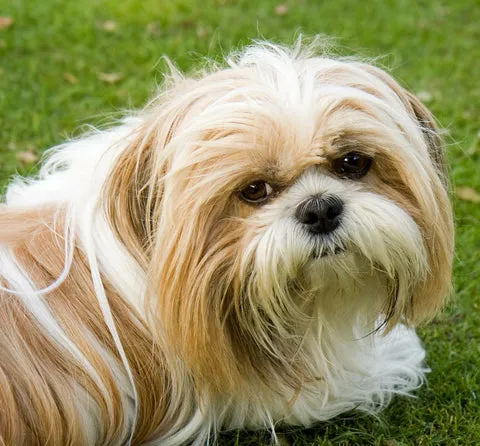 A fluffy Shih Tzu with a long, flowing coat tied in a topknot, exuding charm and affection, a great companion dog.
A fluffy Shih Tzu with a long, flowing coat tied in a topknot, exuding charm and affection, a great companion dog.
A Brief History: Shih Tzus originated in Tibet and were historically revered as symbols of royalty. They were frequently exchanged as precious gifts among Chinese and Tibetan royalty. The name “Shih Tzu” translates to ‘Little Lion’ in Mandarin, inspired by the Buddhist God of Learning, Manjushri, who was believed to travel with a miniature lion dog capable of transforming into a full-sized lion.
| Features | Details |
|---|---|
| Size | Small |
| Height | 9 to 10.5 inches |
| Weight | 4 to 7.5 kilograms |
| Characteristics | Shih Tzus are characterized by their dense, long double coat, which gives them a distinctive appearance. They also have a heavy volume of hair on their heads, often styled in a topknot. They can be found in various solid colors such as brown or white, and have a muscular build with a deep, broad chest region. |
| Group | Toy Dog |
| Temperament | Affectionate, independent, playful, sociable, loyal, and alert, Shih Tzus are known for their charismatic and friendly disposition. |
| Exercise | Shih Tzus have minimal exercise requirements, making them suitable for apartment living. Short daily walks and indoor playtime are usually sufficient to keep them healthy and content. |
| Grooming | Due to their long, flowing coats, Shih Tzus require daily brushing to prevent matting and keep their fur healthy. A bath every 10-15 days helps maintain cleanliness. To protect their eyes from irritation, the hair on their head must be regularly trimmed or tied into a topknot. Their ears should be cleaned, and nails trimmed on a regular basis. Professional grooming is often necessary to properly manage their extensive grooming needs. |
| Health conditions | Shih Tzus are prone to health conditions such as hip dysplasia, cataracts, retinal atrophy, and corneal dryness. Regular screening for these conditions is important to ensure their well-being. |
| Food Doggie Dabbas Recommends | Sardine Oil, Hemp Seed Oil, Fresh Meals, Jerky Treats, Non-Veg Lover Bundle |
Siberian Husky
The Siberian Husky frequently wins the title for India’s most visually striking and unique dog breed. This blue-eyed wonder has seen its popularity skyrocket in India in recent years. As classic Northern dogs with a natural “winter wear” coat, they are inherently designed for cold temperatures.
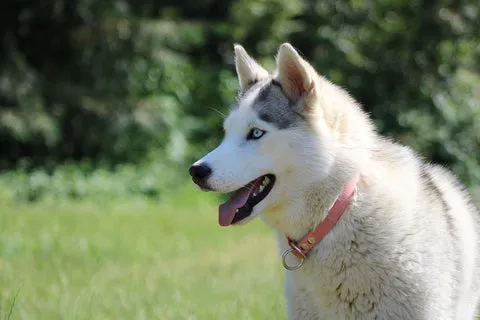 A beautiful Siberian Husky with striking blue eyes, showcasing its thick double coat, perfect for colder climates.
A beautiful Siberian Husky with striking blue eyes, showcasing its thick double coat, perfect for colder climates.
A Brief History: The Siberian Husky was originally bred by the Chukchi people of Siberia for a multitude of roles: as companions, guard dogs, and crucial sled dogs. Their fame spread globally when they were instrumental in transporting antitoxins to Nome, Alaska, during the diphtheria epidemic of 1925, a heroic feat that captured the world’s attention.
| Features | Details |
|---|---|
| Size | Medium-Large |
| Height | 19 to 23 inches |
| Weight | 20 to 35 kilograms |
| Characteristics | Siberian Huskies are identifiable by their thick manes and a medium-length double coat, expertly designed to withstand temperatures as low as -75°F. Their coat colors range from pure black to pure white, often with striking red and white combinations. They possess erect ears, straight necks, and a level topline, contributing to their athletic appearance. |
| Group | Working Group |
| Temperament | Intelligent, friendly, gentle, alert, independent, and notably stubborn. Huskies are known for their mischievous yet affectionate personalities. |
| Exercise | Huskies are highly athletic dogs with significant exercise requirements. As members of the working group, regular and vigorous physical activity is essential for their mental and physical health. Without adequate stimulation, they can become bored and destructive. |
| Grooming | Siberian Huskies are double-coated dogs, making them prone to excessive shedding, especially during seasonal ‘blows’ when they shed their undercoat heavily. Daily brushing is necessary to manage this. During heavy shedding periods, a de-shedding tool is highly recommended. Despite their thick coats, they are remarkably clean animals and do not require frequent baths. Their nails, like any other breed, must be kept short to prevent pain and discomfort. |
| Health conditions | While generally a healthy breed, Huskies can be susceptible to health issues such as juvenile cataracts and hip dysplasia. Responsible breeders will screen for these conditions. |
| Food Doggie Dabbas Recommends | High-Value Training Treats, Sardine Oil, Hemp Seed Oil, Non-Veg Fresh Meals, Non-Veg Lover Bundle |
Dachshund
This distinctive, sausage-shaped dog is an undeniable head-turner! The Dachshund’s lively and playful character, combined with its short coat and small size, makes it an easy-to-maintain and apartment-friendly option among the various dog breed breeds of dogs in India. For those seeking a furry companion that fits well into urban living, they are an excellent choice.
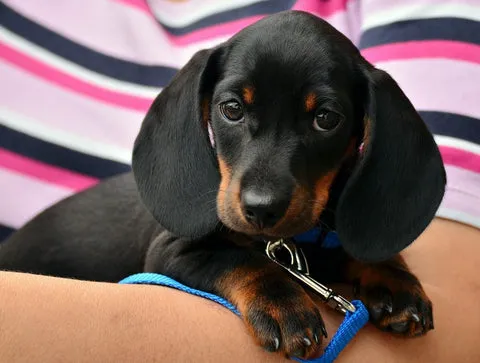 A long-bodied Dachshund with short legs and floppy ears, looking alert and curious, an ideal apartment-friendly pet.
A long-bodied Dachshund with short legs and floppy ears, looking alert and curious, an ideal apartment-friendly pet.
A Brief History: The name “Dachshund” literally translates to ‘badger dog’ in German. This breed was specifically developed for its ability to hunt badgers, burrowing into their dens. Historically, they were categorized into two main sizes: standard-sized Dachshunds were used for hunting formidable prey like wild boars and badgers, while miniature Dachshunds were primarily bred for hunting smaller animals such as hares and foxes.
| Features | Details |
|---|---|
| Size | Small to Medium (Standard and Miniature varieties) |
| Height | 5 to 9 inches |
| Weight | 3 to 12 kilograms (depending on variety) |
| Characteristics | Dachshunds are easily recognizable by their very long bodies and disproportionately short legs. They feature broad foreheads, long and pointed noses, characteristic floppy ears, curved tails, and deep chests, giving them their unique elongated silhouette. |
| Group | Hound Group |
| Temperament | Playful, friendly, lively, alert, independent, stubborn, and clever. Their personality is often bigger than their small stature. |
| Exercise | Despite their small size, Dachshunds require regular exercise to stay fit and develop strong core muscles to support their long backs. It is crucial to prevent them from running up and down stairs or hopping on and off furniture excessively, as these actions can lead to serious spinal injuries due to their predisposition to disc damage. |
| Grooming | Dachshunds do not shed excessively, though shedding varies slightly by coat type (smooth, longhaired, wirehaired). Smooth-coat Dachshunds require less frequent brushing compared to long-haired varieties. Like other breeds, their nails must be kept short to prevent discomfort and potential back issues. |
| Health conditions | Due to their distinctive long backs, Dachshunds are highly prone to intervertebral disc disease (IVDD) or slipped discs. Adequate exercise to maintain a healthy weight and strong muscles is vital for prevention, along with careful handling. They are also susceptible to ear infections if their floppy ears are not properly maintained and cleaned. |
| Food Doggie Dabbas Recommends | Jerky Treats, Sardine Oil, Hemp Seed Oil, Fresh Meals, Freshibble |
Indies (Indian Pariah Dog)
Indies, also widely known as Indian Pariah Dogs or Desi Dogs, are indigenous to the Indian subcontinent. This naturally evolved breed is commonly found across India and is increasingly popular for adoption within the country, often utilized as guard or police dogs due to their robust nature and intelligence. They are a resilient and adaptable dog breed breeds of dogs in India. For individuals seeking apartment-friendly options that don’t shed excessively, it’s worth exploring good house dogs with minimal shedding.
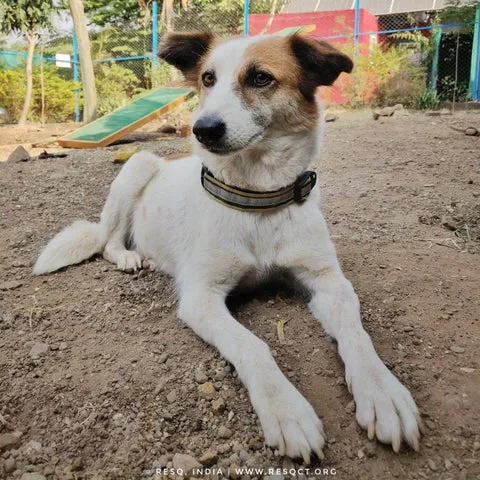 A confident Indie dog (Indian Pariah Dog) with short brown fur and alert, pointed ears, a resilient and adaptable companion.
A confident Indie dog (Indian Pariah Dog) with short brown fur and alert, pointed ears, a resilient and adaptable companion.
A Brief History: This ancient breed is distributed throughout South Asia. While their exact origin remains shrouded in history, archaeological evidence suggests that these dogs have coexisted with humans for over 12,000 years. They served as vital hunting companions for various tribes across the country and are prominently featured in Indian art, culture, and heritage through sculptures, paintings, and folklore.
| Features | Details |
|---|---|
| Size | Medium |
| Height | 20 to 25 inches |
| Weight | 12 to 20 kilograms |
| Characteristics | Indies typically have a square or rectangular build with a short double coat, featuring a soft undercoat and a thick overcoat. They possess erect ears and a characteristic curled tail. Common coat colors include various shades of light and dark brown, white, black, and reddish-brown. |
| Group | Primitive/Pariah |
| Temperament | Friendly, protective, playful, loving, territorial, and intelligent. They are known for their strong pack instincts and loyalty to their families. |
| Exercise | Indies require regular and ample exercise to maintain their physical and mental well-being. This should include daily walks, runs, and even swims. Without adequate physical activity and mental stimulation, they may develop destructive behaviors. Sniffing games and puzzle toys are also excellent for engaging their minds. |
| Grooming | Dogs of this breed shed very little and demand minimal attention when it comes to grooming, making them a low-maintenance choice. They typically do not have strong body odors, and occasional baths are usually more than sufficient. While well-suited for tropical temperatures, they may struggle in extreme heat or cold environments. Regular nail trimming is necessary to avoid pain and discomfort. |
| Health conditions | This breed is renowned for being one of the healthiest, with very few genetic disorders. Conditions such as hip dysplasia, which are common in many purebreds, are rare in Indies. Their natural selection process has made them incredibly robust. |
| Food Doggie Dabbas Recommends | Chicken Jerky, Fresh Meals, Training Treats, Sardine Oil |
Frequently Asked Questions About Dog Breeds in India
Which dog food is famous in India?
Traditionally, boiled chicken and rice, and milk with roti, have been popular choices for dog food in India. For those who prefer commercially prepared diets, kibble is widely used. However, relying solely on rice and chicken over an extended period might not provide a balanced diet, as dogs require food rich in protein and other essential nutrients for optimal health. Always consult with a veterinarian to ensure your dog’s diet meets all nutritional requirements.
Which dog breed is better for a family in India?
For dog lovers and prospective puppy adopters in India, popular and well-suited dog breeds for families include Labradors, Golden Retrievers, Pugs, and Indian Pariah Dogs (Indies). These breeds generally adapt well to family life and the Indian climate. Siberian Huskies, despite their beauty, are generally not recommended for most of India’s tropical climate due to their thick double coats being designed for extremely cold weather, which can be detrimental to their health in warmer regions. If you are specifically interested in American Pit Bull puppies, you may want to learn about American Pit Bull puppy prices in India.
Which is the best suited small breed dog in India?
If you are looking for a small dog that is easy to care for and apartment-friendly in India, excellent choices include Shih Tzus, Indian Spitzs, Pugs, Dachshunds, and Yorkshire Terriers. These breeds generally have lower exercise needs and can thrive in smaller living spaces, provided they receive adequate attention and daily walks.
Which is the longest living dog breed suitable for India’s climatic conditions?
Indian Pariah Dogs (street dogs or Indies), Beagles, Golden Retrievers, and Chihuahuas are among the longest-living dog breeds that also show good compatibility with the varied Indian tropical climate. Their resilience and generally robust health contribute to their longevity.
Which is the best dog breed for a pet in the metro cities in India?
Metropolitan cities often feature smaller apartments without private yards. In such scenarios, the best dog breeds for dog lovers in metro cities in India typically include Pugs, Dachshunds, Beagles, Golden Retrievers, and Poodles. Indian Spitzs and even Indian Pariah Dogs are also excellent options. However, it is crucial to remember that even these breeds require consistent daily exercise and mental stimulation, ideally for at least two hours outdoors, to ensure their physical and emotional well-being, even when living in an apartment.
Which dog breed is suitable for North Indian Climate?
For the cooler, more diverse climate often found in North India, breeds such as Bhakarwal dogs (indigenous to the region), Rampur Greyhounds, and Bully Kuttas are among the most popular and well-suited types of dogs. Breeds like Siberian Huskies can also thrive in the colder parts of North India, provided their extensive exercise and grooming needs are met.
Which dog breed is best for apartments in India?
For apartment living in India, several breeds can adapt well. Pugs, Dachshunds, Beagles, Golden Retrievers, Poodles, Indian Spitzs, and Indian Pariah Dogs are often recommended. The key to successful apartment living for any breed, however, is ensuring they receive sufficient daily exercise, mental stimulation, and outdoor time, preferably for at least two hours. Without this, even smaller breeds can become bored and destructive.
Conclusion
Choosing the right dog breed to welcome into your home in India involves careful consideration of various factors, from their historical background and inherent characteristics to their exercise, grooming, and health needs. Whether you’re drawn to the protective nature of a German Shepherd, the gentle giant presence of a Great Dane, the merry disposition of a Beagle, the family-friendly Golden Retriever, the charming Pug, the lively Pomeranian, the affectionate Shih Tzu, the striking Siberian Husky, the distinctive Dachshund, or the resilient Indie, each breed offers a unique companionship experience.
Ultimately, responsible pet ownership transcends breed choice, emphasizing a commitment to providing proper nutrition, regular veterinary care, consistent training, and ample love. By understanding the specific requirements of each dog breed breeds of dogs in India, you can ensure a harmonious and fulfilling life for both you and your canine companion. We encourage prospective owners to research thoroughly and consider adoption, giving a loving home to a dog in need.
